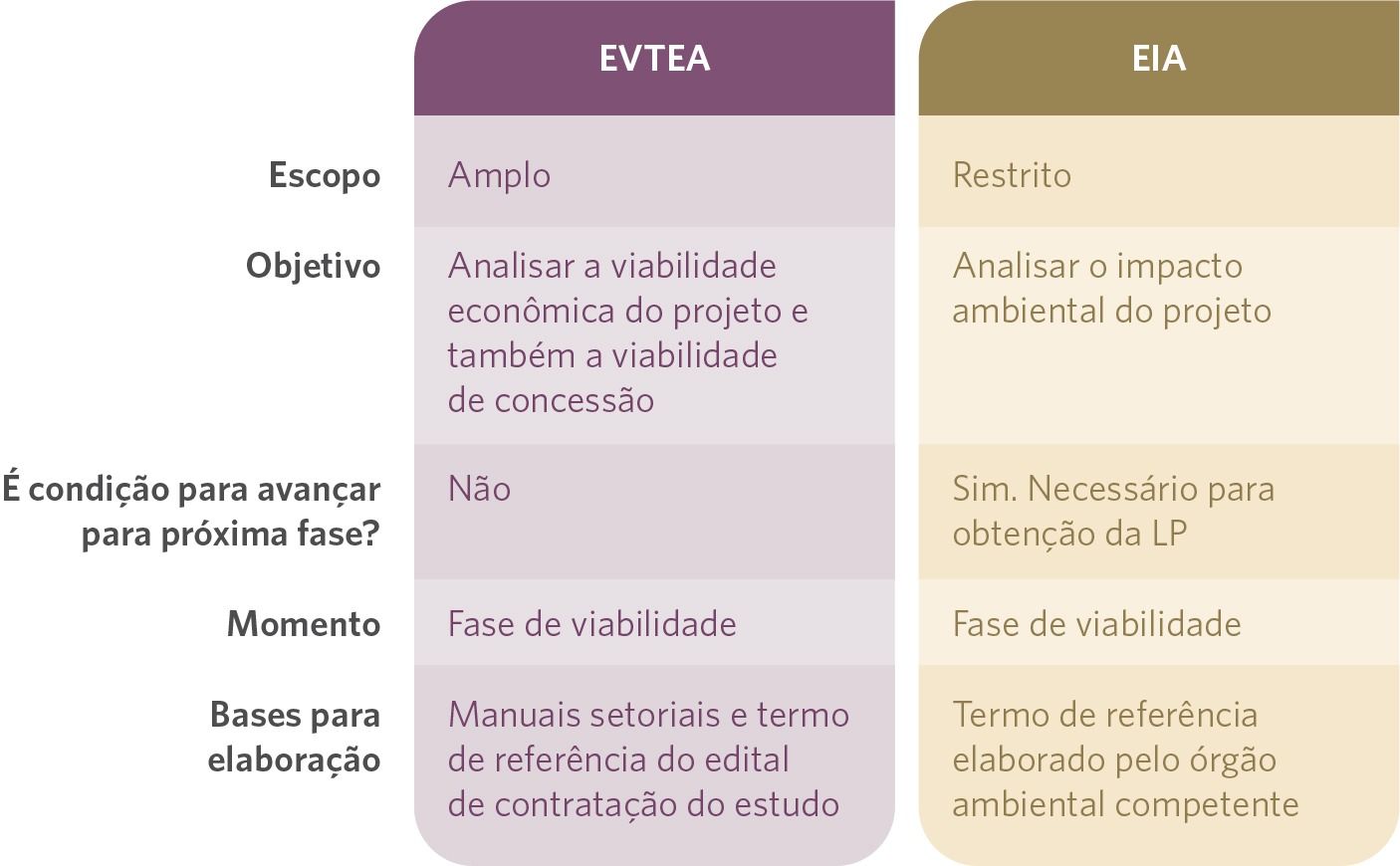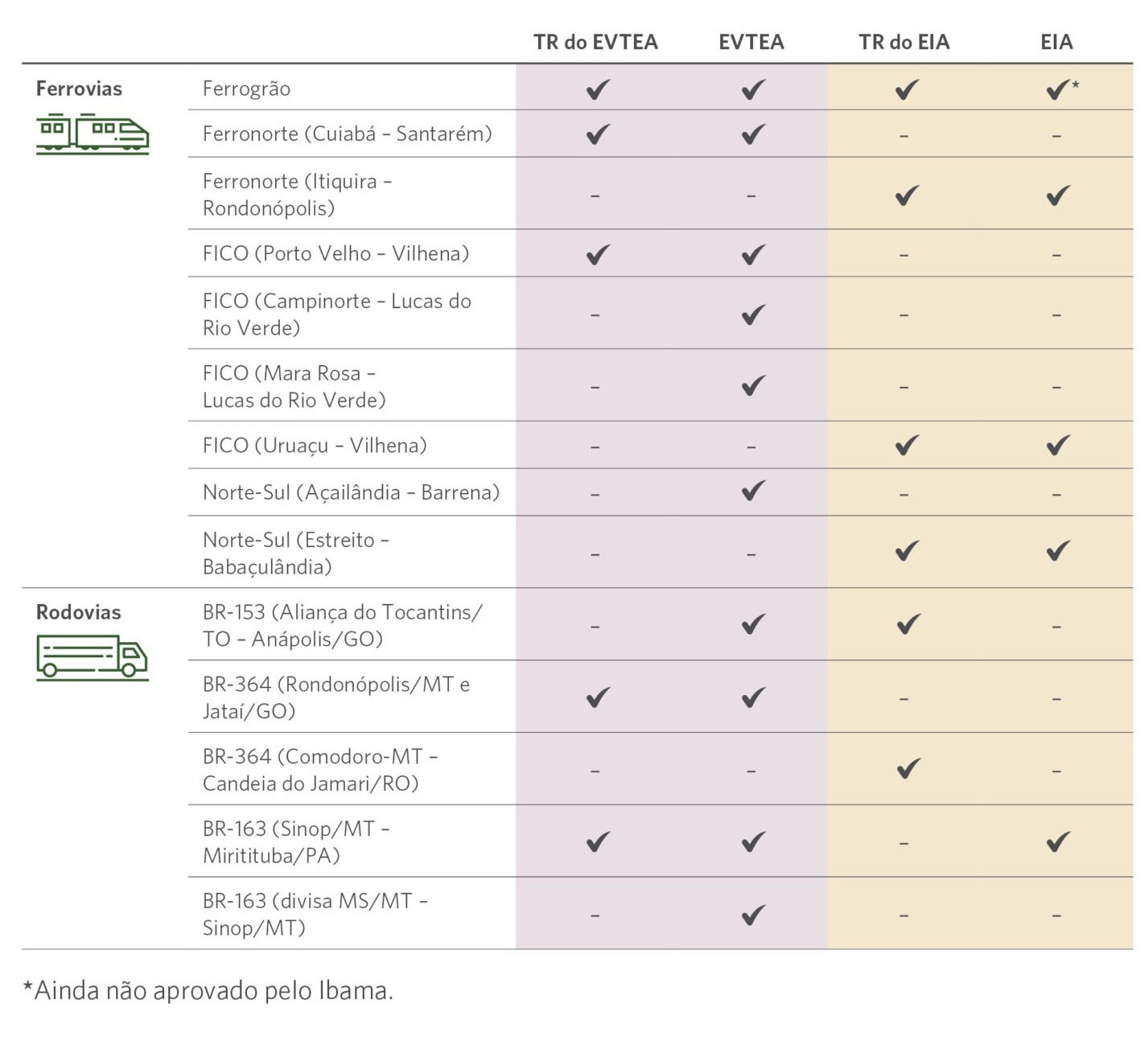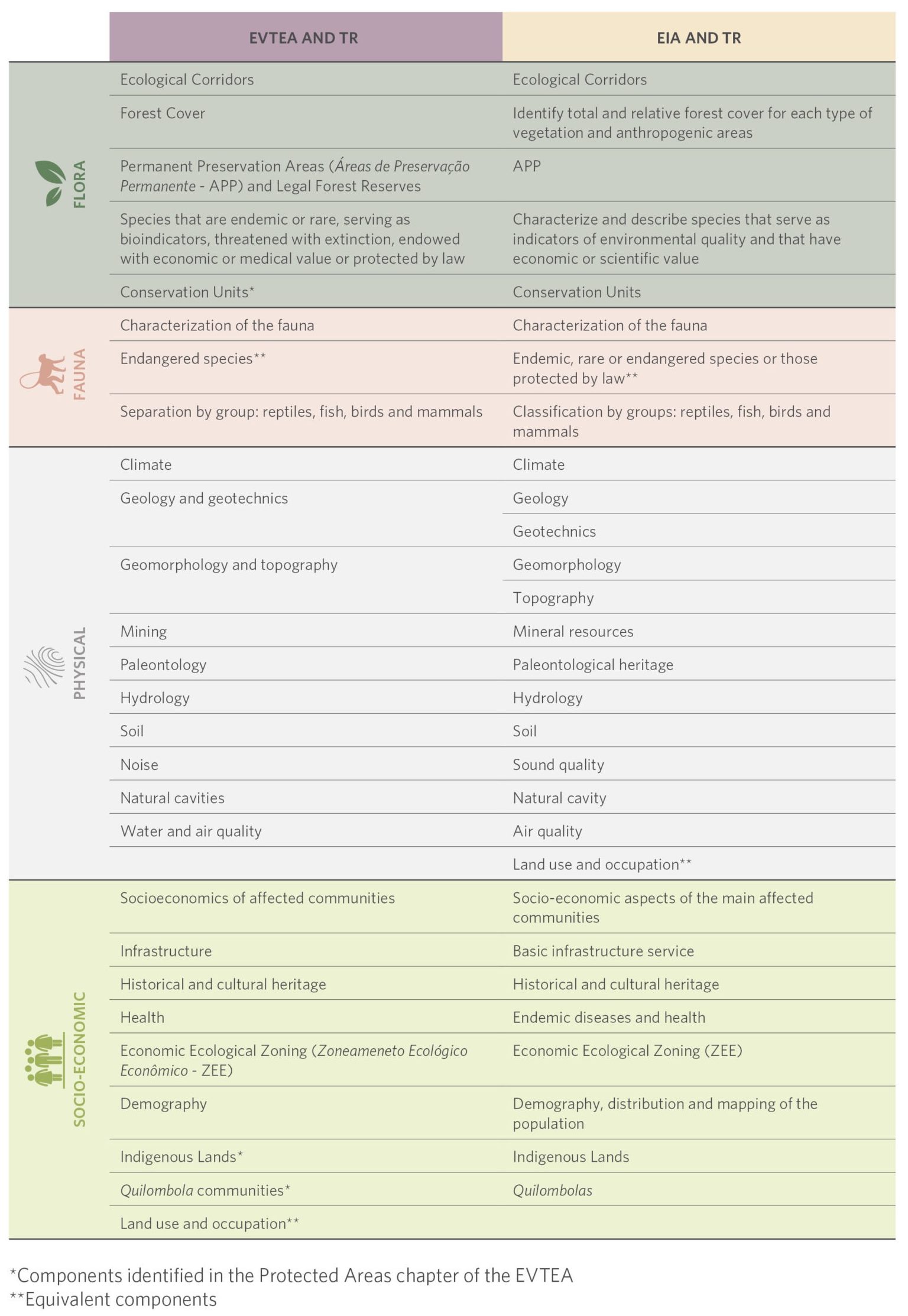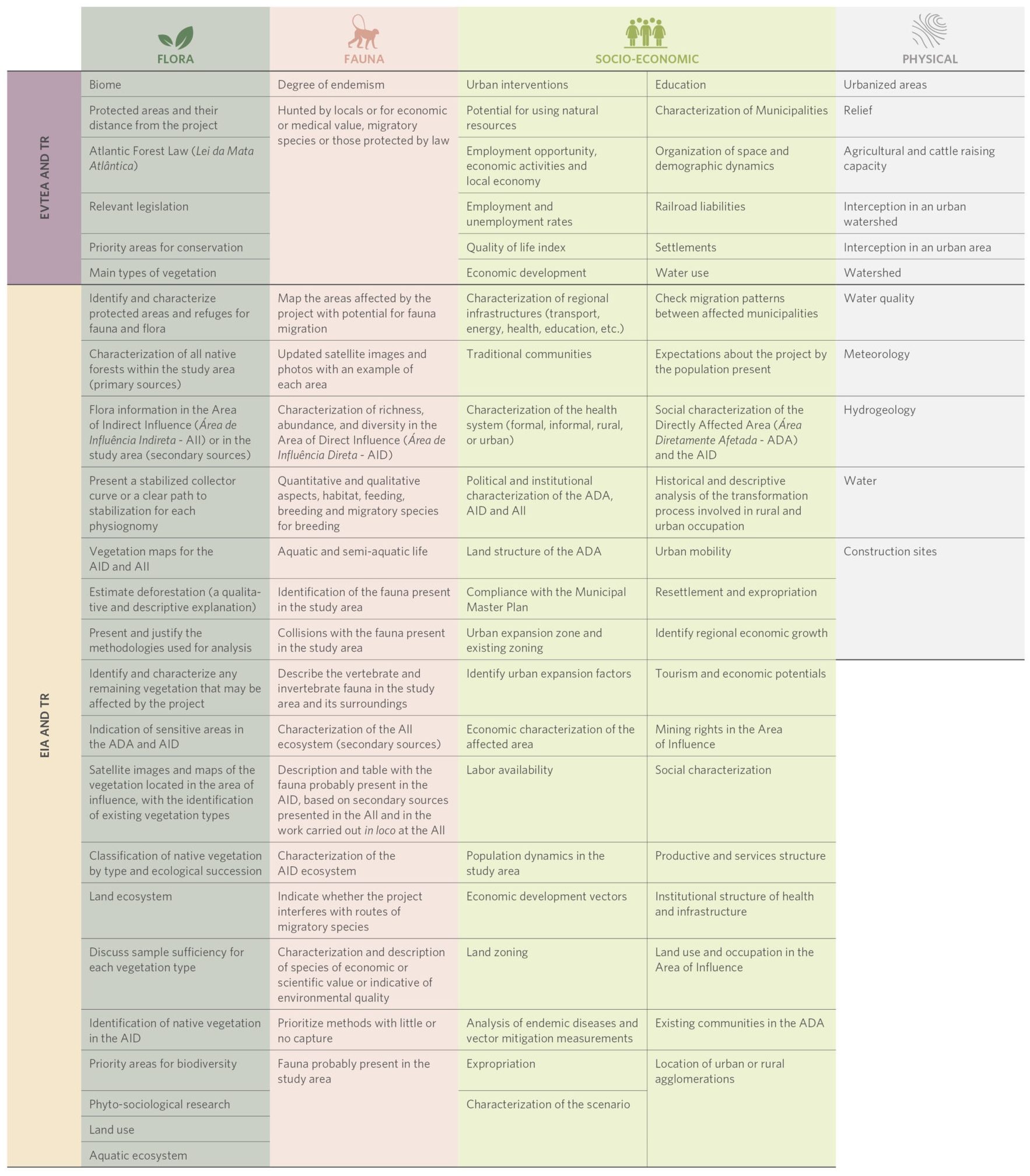INTRODUCTION
The life cycle of infrastructure projects has at least two key points when an analysis of socio-environmental components is expected to be conducted during the implementation of large-scale projects. These are: when the Technical, Economic and Environmental Feasibility Studies (Estudos de Viabilidade Técnica, Econômica e Ambiental – EVTEA) and the Environmental Assessment Study (Estudo de Impacto Ambiental – EIA) are conducted.
Both studies are part of a project’s viability phase. The EVTEA is a more comprehensive study and, in practice, places greater emphasis on investigating the economic feasibility of a given project and the feasibility of the concession itself; it also devotes a section to a socio-environmental analysis. The EIA, as its name implies, focuses on the environmental impacts a project may cause.
The more robust and effective these environmental studies are, the lower the probability is the actual projects implemented will harm the environment. Additionally, improved studies also produce better input to increase the quality of projects. Non-feasible or low-viability projects are less likely to reach the bidding stage. As a result, higher-quality environmental studies make the business environment more secure and reduce transaction costs in the sector.
In this brief, researchers from Climate Policy Initiative/Pontifical Catholic University of Rio de Janeiro (CPI/PUC-Rio) identify and analyze the socio-environmental components covered by the terms of reference for EVTEA and EIAs, the studies themselves, the highway and railroad sectoral manuals used to prepare EVTEA, and by the ten most important socio-environmental components foreseen in international guidelines for railroad and highway projects surveyed under this study.
This analysis (i) checks whether the socio-environmental components of EVTEA and EIAs have different emphases, (ii) ascertains whether the terms of reference (TRs) for EVTEA and EIAs and the studies themselves incorporate the most relevant socio-environmental components in accordance with the international guidelines surveyed, as well as those outlined in highway and railroad sectoral manuals and, finally, (iv) checks whether the environmental studies have complied with the provisions in their respective TRs.
RECOMMENDATIONS
• Improve the terms of reference for studies and the analysis of socio-environmental components in Technical, Economic and Environmental Feasibility Studies (EVTEA) and in the Environmental Assessment Study (EIA) by incorporating international guidelines.
• Incorporate the social and environmental components included in sectoral manuals into the terms of reference for EVTEA or in the EVTEA bid notices, thus making them binding.
• Ensure a process with clear and transparent criteria for the assessment and approval of environmental studies by requiring full compliance with the terms of reference for EVTEA and EIAs and sectoral manuals or by providing a technical justification for the lack thereof.
• Make it mandatory for EVTEA to be conducted before EIA.
KEY FINDINGS
i. Environmental studies include more components related to the socio-economic and physical environments, than they do to the biotic environment. The number of components pertaining to the physical and socio-economic components in EVTEA reinforces the current emphasis on technical and economic feasibility, thus missing an opportunity to conduct a more robust analysis of the biotic environment earlier in the process and incorporate them into project feasibility equation prior to the environmental licensing procedure.
ii. Approximately 30% of the components analyzed in the EIAs are also analyzed in the EVTEA. This shows that there would be a significant efficiency gain if there were a mandatory correlation between the two studies. There is also a clear possibility for EVTEA to conduct certain analyses prior to when they would otherwise be conducted (in the EIAs), since the components analyzed in both studies are fully compatible.
iii. The studies do not fully follow the sectoral manuals, which indicates that improving and standardizing sectoral manuals and TRs alone may not be enough if they’re not mandatory.
iv. The environmental studies analyzed fail to consider all the ten most relevant social and environmental components laid out in international guidelines in the railroad and highway projects surveyed for this study.
v. Environmental studies fail to fully comply with their TRs.
1. THE VIABILITY PHASE FOR LAND INFRASTRUCTURE PROJECTS
This research conducted by CPI/PUC-Rio[1] focuses on the regulations applicable to federal railroad and highway concessions to the private sector[2] and identifies the main phases and stages of the concession flow, as illustrated in Figure 1.
Figure 1. Life Cycle Stages of Land Transport Projects

Source: CPI/PUC-Rio, 2021
In the viability phase, cost-benefit analyses and technical and environmental feasibility studies are carried out to determine whether a project is, in fact, viable for execution. EVTEA are the studies used to identify these issues and describe them in detail. The government also decides in the viability phase which public agency or institution will be centrally responsible for spearheading the project; for the cases considered in this brief, it is usually the National Land Transport Agency (Agência Nacional de Transportes Terrestres – ANTT) or VALEC Engenharia, Construções e Ferrovias S/A (VALEC).
After that, the environmental licensing process begins. A Preliminary License (Licença Prévia – LP) is the first of three environmental licenses that must be granted to land infrastructure projects before implementation and operations can begin. The LP attests to a project’s environmental feasibility and can be obtained by the initiative of the government or the concessionaire. This first license is part of the viability phase, as it attests to a project’s environmental feasibility; no project can be undertaken without it.
Issuance of the LP is based on an analysis of the respective EIA,[3] which does not necessarily have to pre-date the EVTEA or even be logically correlated with it, according to the regulations currently in effect.[4] This lack of a relationship between the studies squanders an opportunity for issues discussed only in the environmental licensing stage to be addressed earlier, during the EVTEA.
Box 1. Environmental Studies Foreseen throughout the Life Cycle of an Infrastructure Project

Note: Terms of Reference from institutions potentially involved are also used as a basis for preparing EIAs. See: Inter-ministerial Ordinance no. 60/2015. bit.ly/3pGz49W.
Source: CPI/PUC-Rio, 2021
2. ANALYSIS OF FEDERAL HIGHWAY AND RAILROAD CONCESSIONS IN THE LEGAL AMAZON
To analyze the socio-environmental components included in environmental studies (EVTEA and EIAs), first information must be obtained about them, including their terms of reference and any government manuals that guide their preparation.
Considering the available documents, 14 sections of highway and railroad projects were analyzed in total, broken down into nine railroad sections and five highway sections. However, only three railroad sections and two highway sections had both the EVTEA and its TR available for analysis; these were acquired by means of the Information Access Law (Law no. 12527/2011). Only three railroad sections had their EIAs and respective TRs available for analysis. In the highway sector, there were no EIAs and respective TRs available for any of the sections under analysis (Table 1).
Table 1. Sections of Highway and Railroad Concessions under Analysis and Documents Made Available through LAI

Source: CPI/PUC-Rio, 2021
It should be noted that only one project (Ferrogrão) had complete information available on all environmental studies (and their TRs) that should be carried out throughout the life cycle of any project, corroborating the lack of transparency in this sector as previously reported by CPI/PUC-Rio.[5]
3. SOCIAL AND ENVIRONMENTAL COMPONENTS UNDER ANALYSIS
The first step of the analysis carried out by CPI/PUC-Rio researchers identified the socio-environmental components adopted in the environmental studies and their TRs to find out if there is an emphasis on any specific socio-environmental aspect and if the EVTEA and EIAs focus on the same aspects.[6]
Annexes 1 and 2 illustrate all the socio-environmental components identified in the studies and their TRs under assessment. In total, 57 components were identified as present in the EVTEA and their TRs and 98 components were identified in the EIAs and their TRs. Of the 98 components identified in the EIAs and their TRs, 29 are also present in EVTEA and their TRs. Therefore, almost 30% of the components analyzed in the EIAs are also analyzed in the EVTEA. This shows that there would be a significant efficiency gain if there were a mandatory correlation between the two studies. There is also a clear possibility for EVTEA to cover certain analyses prior to when they would otherwise be conducted during the EIAs, since the components analyzed in both studies are fully compatible.
3.1 DISTRIBUTION OF SOCIAL AND ENVIRONMENTAL COMPONENTS IN THE EVTEA AND EIAS FOR RAILROAD AND HIGHWAYS
From the outset, it should be noted that this is merely a quantitative analysis conducted to understand the distribution of socio-environmental components across the studies and TRs under analysis. Such distribution does not consider the depth or quality of the analysis for each component in the studies and TRs; it only illustrates which socio-environmental aspects (the biotic – fauna and flora -, physical and socio-economic environments) had more or fewer components detailed in the studies.
The EVTEA TRs and the EVTEA themselves, in their majority, had more components related to the socio-economic environment, followed by the physical environment. The biotic environment, separated into flora and fauna, had fewer components under study; of the two, the fauna had the fewest components under analysis. Considering that the EVTEA currently does not focus on a project’s socio-environmental feasibility (Box 1), it is not surprising that there are more components focused on the physical and socio-economic environments, which have a more direct impact on a project’s technical and economic feasibility analysis.
While the highway sector’s EVTEA and EVTEA TRs include a higher number of socio-environmental components under study, in the case of EIAs the higher number of such components is in the railroad sector.
Figure 2. Distribution of Socio-economic Components across Highway and Railroad EVTEA and EIAs

Source: CPI/PUC-Rio, 2021
Like EVTEA, the TRs and the EIAs in both sectors consider only a few fauna-related components. Though such component is part of the TR for highway projects, it is not analyzed in the actual studies. Flora-related components are also limited, especially in the highway sector, which is alarming given the widely recognized negative impact that these types of projects have in terms of deforestation.
As such, studies and their respective TRs have more components tied to the assessment of the socio-economic and physical environments, while the biotic environment – comprised of fauna and flora – has quantitatively fewer components analyzed.
3.2 MOST RELEVANT SOCIO-ENVIRONMENTAL COMPONENTS
The second step in the analysis was based on a survey of international guidelines carried out by a team of consultants[7] to identify the ten most relevant social and environmental components for railway and highway projects.[8],[9],[10],[11],[12],[13],[14]
They are as follows: (i) forest cover, (ii) conservation unit, (iii) biodiversity and natural habitat, (iv) indigenous and quilombola communities, (v) natural caverns, (vi) water resources, (vii) historical and cultural heritage, (viii) riverine communities, (ix) air quality, and (x) climate.
These guidelines also seem relevant for Brazil, considering that the Social and Environmental Scope for Evaluation and Structuring of Highway Concessions (Escopo Socioambiental para Avaliação e Estruturação de Concessões Rodoviárias – ESAEC-R) – a document prepared (though not yet formally published) by the Ministry of Infrastructure to standardize EVTEA TRs for highway concession[15] – includes most of the social and environmental components identified internationally. The only components missing from the ESAEC-R are: air quality and riverine communities.
A comparison between international guidelines and the components identified in the EVTEA for the selected projects shows that none of the EVTEA had analyzed all ten of the components listed above. Only two components had been included in all EVTEA under review: conservation units and indigenous and quilombola communities. Riverine communities, on the other hand, were not included in any of the studies – probably because there is no specific legislation in place to protect them. Figure 3 shows the share of EVTEA and TRs for EIAs that considered each of the ten components provided for in international guidelines.
Figura 3. Most Relevant Components Considered by EVTEA and TRs for EIAs

Source: CPI/PUC-Rio, 2021
In the case of EIA TRs, none of the projects under analysis incorporated all the components included in international guidelines into the TRs for the EIAs under assessment. Once again, riverine communities were not covered in any study.
It should be noted, however, that certain components may be missing because of the location of the segment in question, which may simply have no impact on a particular component. However, considering that these studies – both EVTEA and EIAs – are preliminary to the final project design, there should at least be a justification for why the component was not addressed.
3.3 EVTEA COMPLIANCE WITH SECTORAL MANUALS FOR THE PREPARATION OF EVTEA
The third step in the analysis was determining whether the EVTEA do, in fact, include the socio-environmental components provided for in the sectoral manuals for the preparation of EVTEA – issued by the National Department of Traffic Infrastructure (Departamento Nacional de Infraestrutura de Trânsito – DNIT) for the highway sector and by VALEC for the railroad sector. It turns out that these manuals are not entirely followed. The railroad sector has incorporated, on average, 47% of the components provided for in VALEC’s manual, while the highway sector has incorporated, on average, 54% of the components provided for in DNIT’s manual.
Figura 4. EVTEA Compliance with Sectoral Manuals

Source: CPI/PUC-Rio, 2021
In view of the government’s ongoing efforts to standardize EVTEA TRs by means of sector manuals, as in the case of the ESAEC-R mentioned above, it is not enough to have a robust manual in place for the preparation of environmental studies if the social and environmental components it provides for are not included in the terms of reference for contracting studies or in the EVTEA bid notices and if compliance is not duly assessed and approved.
3.4 COMPLIANCE BETWEEN STUDIES AND THEIR TERMS OF REFERENCE
The fourth and final step was to determine whether the environmental studies fulfilled the items in their respective terms of reference. Though some of the studies looked into components not originally included in the TR, they also failed to analyze all foreseen components, such as the railroad EVTEA, as shown in Figure 5. Highway EVTEA, on the other hand, complied with their terms of reference.
Figure 5. Number of Socio-environmental Components per EVTEA and EIA Compliance with TRs

Source: CPI/PUC-Rio, 2021
In the case of EIAs, none of them were fully compliant with the TR, though there were cases where the study was fully compliant in certain regards. In one case, for example, the study analyzed components not included in the TR.
CONCLUSION
In this brief, CPI/PUC-Rio researchers identify the socio-environmental components covered by sectoral manuals, terms of reference for EVTEA and EIAs and by the studies themselves, as well as by the international guidelines, for federal highway and railroad concessions in the Legal Amazon.
The study finds that the EVTEA and EIAs under analysis, as well as their TRs, have more components related to the socio-economic and physical environments. While this is a quantitative analysis, it is noteworthy that the biotic environment, which is essentially environmental in nature, has fewer components than other socio-environmental aspects, especially in EIA TRs and in the EIAs themselves, since they focus on projects’ environmental impacts.
CPI/PUC-Rio identified room to improve the TRs for EVTEA and EIAs by incorporating the components outlined in international guidelines, such as riverine communities, and sectoral manuals, like endangered fauna species. However, strengthening the TRs alone will not be enough unless the studies actually fully comply with them. A clear and transparent process for evaluating and approving studies must be in place to ensure full compliance with TRs and sectoral manuals, or there should a proper justification if that is not the case.
ANNEXES
Anexo 1. Equivalent Social and Environmental Components Identified in both the EVTEA and the EIA and their TRs

Source: CPI/PUC-Rio, 2021
Anexo 2. Other Social and Environmental Components Identified in both EVTEA and EIA and their TRs

Source: CPI/PUC-Rio, 2021
The authors would like to thank Natalie Hoover El Rashidy for revision and editing, and Meyrele Nascimento and Nina Oswald Vieira for the graphic design work.
[1] Chiavari, Joana, Luiza Antonaccio and Gabriel Cozendey. Regulatory and Governance Analysis of the Life Cycle of Transportation Infrastructure Projects in the Amazon. Rio de Janeiro: Climate Policy Initiative, forthcoming. See also: Cozendey, Gabriel and Joana Chiavari. Environmental Viability of Land Transport Infrastructure in the Amazon. Rio de Janeiro: Climate Policy Initiative, 2021. bit.ly/3xuebBD.
[2] Initially, the study was going to analyze concessions and non-concessions of federal and state railways and highways in the Legal Amazon, but ultimately state highways and non-concession highways were excluded from the analysis due to the unavailability (or complete lack) of sufficient data. The researchers did not find any railways not under concession in the Legal Amazon.
[3] The EIA is approved after a public hearing, which also serves as input for the analysis to approve the LP.
[4] Cozendey, Gabriel and Joana Chiavari. Environmental Viability of Land Transport Infrastructure in the Amazon. Rio de Janeiro: Climate Policy Initiative, 2021. bit.ly/3xuebBD.
[5] Cozendey, Gabriel and Joana Chiavari. Environmental Viability of Land Transport Infrastructure in the Amazon. Rio de Janeiro: Climate Policy Initiative, 2021. bit.ly/3xuebBD.
[6] The components identified are described in detail in Annexes 1 and 2.
[7] Halrik, Carlos and Thomas Miazaki. Consultancy services contracted by the Climate Policy Initiative. December, 2019.
[8] Quintero, Juan D. A Guide to Good Practices for Environmentally Friendly Roads. Latin America Conservation Council. 2016. bit.ly/3pEBC8s.
[9] Infra Eco Network Europe. International Guidelines for Ecologically-adapted Linear Infrastructure. 2018.
[10] International Road Federation. Moving Towards Green Road Infrastructure. 2013. bit.ly/3gifJHK.
[11] The World Bank. Roads and the Environment: A Handbook. 1997.
[12] International Finance Corporation. Environmental, Health, and Safety Guidelines for Railways. 2007. bit.ly/359S1Zo.
[13] International Finance Corporation. Environmental, Health, and Safety Guidelines for Toll Roads. 2007. bit.ly/3pDrxJ6.
[14] The World Bank. Environmental and Social Framework. 2017. bit.ly/3zjAnQr.
[15] A query was made via the Freedom of Information Act as to the possibility of making the ESAEC-R and ESAEC-F available and whether they were in effect. For the ESAEC-R, the response was that “the document had been approved by the Permanent Commission on Highway Concessions (Comissão Permanente de Outorgas Rodoviárias – CPOR) on December 21, 2017, and later updated and submitted for validation by CPOR on June 12, 2019”. When CPOR was extinguished by Decree no. 9,759 on April 11, 2019, however, the document had not yet been validated. Nevertheless, the response to the question formulated via the LAI states that the document “is already used as a reference for the preparation of Technical, Economic and Environmental Feasibility Studies (EVTEA) for highway concessions”. Regarding the ESAEC-F, the request to make that document available was denied because the council in charge of approving it had been extinguished (by the same decree that extinguished the CPOR).

